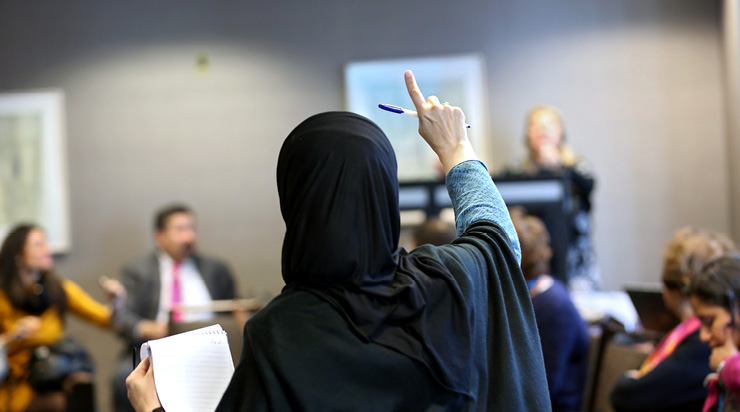Jeni Klugman and Marianne Dahl respond to ‘How (not) to make WPS count’, a commentary on the WPS Index by Anu Mundkur and Laura Shepherd.
Yesterday this site published a piece by Anu Mundkur and Laura Shepherd (AM and LS), both welcoming and critiquing the new WPS Index, which was published by the Georgetown Institute of Women Peace and Security and the Peace Research Institute Oslo in October 2017. In particular the authors welcomed the fact that the Index is drawing attention to gendered dynamics of peace, security and justice – making such issues count.
Our response is limited to aspects in the post that may be misleading. First, the authors claim that the construction of the Index is opaque. However the launch report devotes considerable space to describing the construction of the Index, outlining the data sources and rationale for selection, and outlining the aggregation methods, with an appendix providing methodological details and country level examples.
Second, AM and LS ask why we need a new index. As we underlined in the launch report (especially chapter 1), there are a growing number of global indices. Many will be familiar with the gender rankings in the Human Development Report and by the World Economic Forum, for example. We reviewed the existing indices and realized that there was a major gap.
Gender indices are typically limited to such indicators as whether women complete secondary school or are in paid work. These aspects of inclusion are undoubtedly important, but incomplete in the absence of justice and security. It is surely misleading to focus on girls’ schooling when they are not safe in their own home or community. Likewise, traditional measures of security include an array of conflict indicators, but invariably ignore systematic bias and discrimination against women and girls.
No index has ever before brought together women’s inclusion, justice, and security into a single number and ranking. The WPS Index represents a major innovation in how we think about and measure women’s wellbeing by bringing achievements in, for example, schooling and access to cell phones, together with data on violence against women, covering more than 98 per cent of the world’s population.
The goal is very much to capture the breadth and complexity of the WPS agenda, beyond the Security Council resolutions, as AM and LS advocate.

The WPS Index uses internationally comparable data from published sources. This brings us to a criticism raised by AM and LS of our deliberate decision not to rely on WOMENSTATS as a data source, and questioning the value added of the WPS Index relative to WOMENSTATS. The WOMENSTATS database brings together a range of important data and indicators – but in converting the raw data into ordinal scores, WOMENSTATS loses a lot of information, as scores which in principle can vary from 0-100, are presented as just numbers between zero and five. The use of these types of multivariate scales, as opposed to national statistics (as the WPS Index utilizes) obscures country-to-country differences: it is harder to interpret a score of 3 vs. 4 on the Physical Security of Women, for example, than it is to compare IPV prevalence of 42 per cent vs. 26 per cent, or 22 versus 29 per cent. Moreover WOMENSTATS separately scores various dimensions, but does not provide a single summary multidimensional index, nor the overall country rankings that are so powerful politically.
AM and LS appear to misunderstand the point of the discriminatory norms measure. After extensive and exhaustive review of many data sets (Demographic and Health Surveys, World Values and so on), we landed on the resistance to women’s work both because it captures a key aspect of discrimination against women – 74 per cent of Pakistani men don’t think it is acceptable for women to work, which is surely deeply relevant to women’s prospects in that country, for example – and it is available for 150 countries from around the world. Clearly it is not the sole measure of adverse norms – we include son bias and legal discrimination as well as indicators related to women’s economic opportunities (employment, financial inclusion etc).
AM and LS criticize the inclusion of battle-death in organized violence, arguing that this ‘perpetuates particularly pernicious stereotypes – antithetical to supporters of the WPS agenda – of a civilized peaceful global North and an uncivilized and violent global South’. We disagree. To explicitly address this perception we measure security at three levels: in the household, in terms of intimate partner violence; and in the community, whether women feel safe walking in their community at night. Many rich countries do poorly on both fronts – including for example Australia. The third level at which we measure (in)security is in terms of organized violence.
Alongside intimate partner violence and lack of safety in the community, organized violence presents a great threat to women (and men) in many parts of the world, and its exclusion from the Index is not warranted. While it is beyond our Index to say who is responsible for the violence, we can summarize where people are suffering the most – that is, people living in conflict-affected areas, and this is what we are measuring. The costs of the Iraqi war was much more severe for women in Iraq than for women in the United States. Excluding organized violence would omit the tremendous impact such conflicts have on women’s lives. It would not be possible to capture how it is to be a woman in Syria without taking the brutal civil war into account – and indeed Syria ranks (tied) last in the Index. This is not a global North measurement of the global South, as AM and LS claim. It is an objective measurement of where people are dying in the largest numbers due to organized violence – based on the gold standard of conflict data in the field of quantitative research. The article that introduced these data (Gleditsch, Wallensteen, Eriksson, Sollenberg & Strand, 2002) has been cited more than 3000 times in the academic literature, and the annual updates have been cited over 2900 times (Google Scholar, 23 January 2018). And most countries in the “global south” are not affected by organized violence, while some countries in the “global north” are (e.g. France and Ukraine).
We agree with AM and LS that civil society plays a vital role in the promotion of women, peace and security. However since we made a deliberate decision to base all the indicators in the WPS index on population and survey based measures, this ruled out the types of assessments that CIVICUS provides, though this is clearly a useful complement to the picture provided by the WPS rankings.
More generally, as recognized in the report, there are major data constraints. Looking ahead, we hope that the explicit links of all the variables in the WPS Index to the Sustainable Development Agenda’s targets and indicators will help to allow for improvements in the WPS Index over time.
In sum, the new WPS Index provides a simple number and ranking that spotlights achievements and deficits in women’s inclusion, justice, and security, and demonstrates the feasibility of improvement. The aim is to inform and inspire action by governments, multilateral agencies, development partners, civil society and business to advance women’s peace and security, and to help hold governments to account for their commitments to the SDGs and other global commitments.
The views, thoughts and opinions expressed in this blog post are those of the author(s) only, and do not reflect LSE’s or those of the LSE Centre for Women, Peace and Security.






The WPS Index is what many of us with a lifelong interest in the field have been attempting to synthesise at smaller scales, in isolation, imperfectly, against the odds. Congratulations on creating such a sound, evidence-based, realistic method for reflecting women’s lives. I hope it is rapidly and widely applied by duty-bearers in the North and South, as it should be.